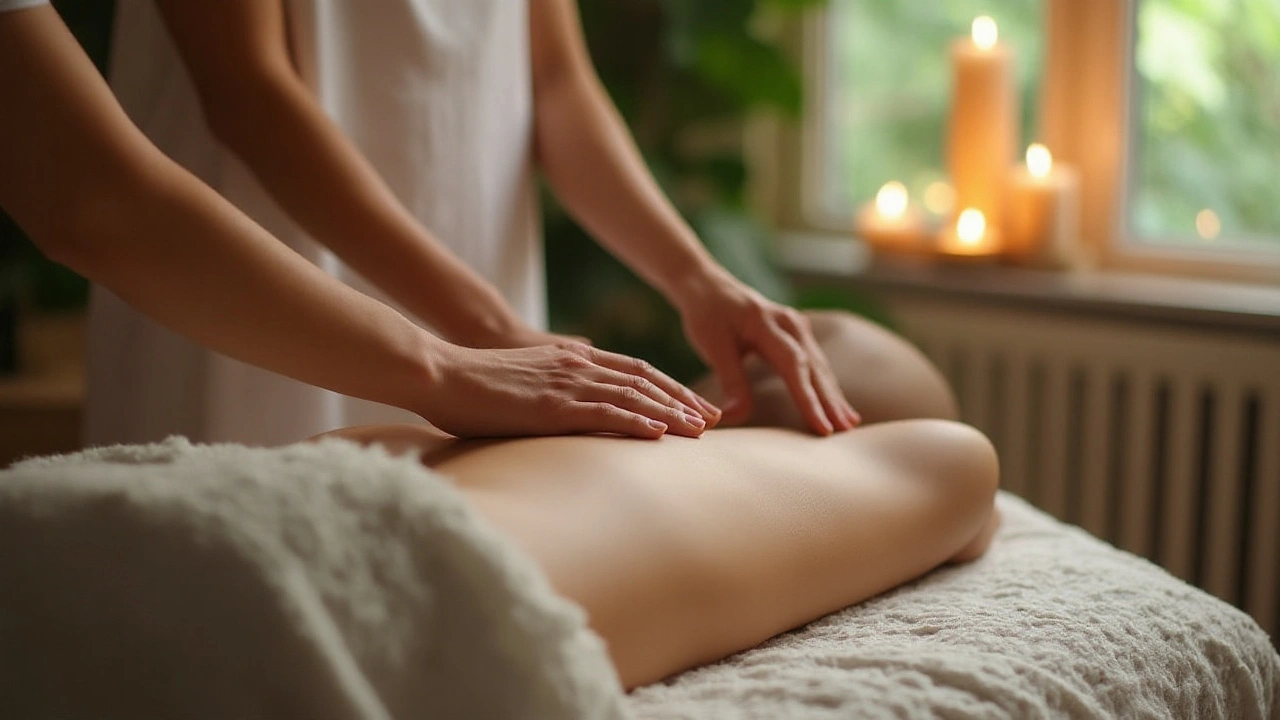Polarity Therapy is an emerging star in the field of holistic health. By targeting energy imbalances in the body, this technique promises a path towards better well-being and natural healing.
This article will dive deep into the concept of Polarity Therapy, showing you what it is, how it works, and the science behind energy balance. You will also learn about its benefits and practical applications. Finally, we'll guide you on how to find a qualified Polarity Therapist to experience the benefits firsthand.
Whether you're new to the idea of holistic treatments or you're looking to expand your knowledge, this comprehensive guide on Polarity Therapy could be just what you need.
- What is Polarity Therapy?
- How Does Polarity Therapy Work?
- The Science Behind Energy Balance
- Benefits of Polarity Therapy
- Practical Applications and Techniques
- Finding a Polarity Therapist
What is Polarity Therapy?
Polarity Therapy is an intriguing and dynamic approach nestled comfortably within the realm of holistic health. This comprehensive system of treatment seeks to balance the body's energy based on the belief that energy flows within the human body and that disturbances in this flow can lead to various health issues. Developed by Dr. Randolph Stone in the mid-20th century, it amalgamates elements from ancient Eastern energy healing techniques with modern Western methodologies.
Dr. Stone's inspiration ranged from Ayurveda, Chinese Medicine, and Hermetic philosophy to osteopathic and chiropractic practices. The cornerstone of Polarity Therapy is maintaining the seamless flow of energy within five elements: Ether, Air, Fire, Water, and Earth. Each of these elements is believed to be associated with specific parts and functions of the body. For example, Fire addresses digestion and metabolism, while Water correlates with the reproductive and lymphatic systems.
The practice involves a unique blend of bodywork, diet, exercise, and self-awareness. Bodywork might include gentle touch, rocking, or pressure point manipulation to clear energy blockages and restore equilibrium. Dietary recommendations focus on eating balanced, whole foods to support overall well-being. Exercises, often called Polarity Yoga, are designed to stimulate and move energy through specific physical postures.
Polarity Therapy also brings a strong emphasis on self-awareness and emotional balance. Practitioners often integrate therapeutic conversations into their sessions to help clients recognize and modify negative patterns or beliefs that may be disturbing their energy flow. This holistic approach aims not only to address physical symptoms but also to foster a sense of mental and emotional harmony.
Dr. Stone once said, "Energy is the real substance behind the appearance of matter and forms". This quote succinctly encapsulates the philosophy driving Polarity Therapy. By focusing on the body's energetic template, practitioners aim to reveal and address the root causes of disharmony rather than merely treating symptoms.
One of the most fascinating aspects of Polarity Therapy is its accessibility and adaptability. It works well both as a standalone practice and in conjunction with other treatments. From chronic pain and stress to digestive issues and emotional challenges, many individuals have found relief and restoration through this method. Intrigued by its potential, more people are turning to Polarity Therapy as a means to achieve a balanced and energized life.
The efficacy of Polarity Therapy has piqued interest in scientific communities as well. Researchers are currently exploring how subtle energy fields interact with physiological processes, lending more credibility to energy-based healing methods. These developments promise to bridge the gap between traditional holistic practices and modern scientific inquiry.
Whether you're seeking relief from a specific ailment or aiming to enhance your overall energy and well-being, Polarity Therapy offers a path worth exploring. Its holistic structure makes it a versatile addition to any wellness regimen, bringing a comprehensive approach to health and healing.
How Does Polarity Therapy Work?
Polarity Therapy works by aligning and balancing the energy flow within the human body. This holistic approach combines touch, diet, exercise, and self-awareness to promote physical and emotional health. The idea rests on the principle that energy, often referred to as life force or 'chi,' flows through the body in specific pathways. When these pathways are blocked or imbalanced, it can lead to various health issues.
A Polarity Therapy session typically begins with a consultation. The therapist will ask about your health history, current issues, and lifestyle. This information helps customize the treatment to your needs. The session itself often involves gentle touch, specialized massage, and sometimes pressure point techniques. The therapist may also guide you through specific exercises or stretches aimed at balancing your energy.
One of the core components of Polarity Therapy is understanding the five elements – ether, air, fire, water, and earth. These elements correspond to different areas of the body and aspects of our emotional and physical life. The therapist works to balance these elements, ensuring that energy flows freely and naturally, thereby promoting overall well-being. For instance, problems in digestion could be related to an imbalance in the fire element, and the therapy would target this specifically.
The science behind Polarity Therapy lies in modern understandings of bioenergetics and traditional concepts like Ayurveda. While Western medicine often focuses on physical symptoms, Polarity Therapy looks at the body as an integrated system where energy and physical health are deeply intertwined. This comprehensive approach often leads to significant improvements even in chronic conditions.
Pierre Pannetier, a noted Polarity Therapy practitioner, once said, "Healing begins when we understand that energy is the foundation of life. Balance the energy, and you balance the person."Polarity Therapy also incorporates dietary guidance. A proper diet ensures that energy flows correctly in the body, reducing possible blockages. Certain foods are recommended to balance specific types of energy, making nutrition an essential part of the healing process. For example, if your energy is sluggish, you might be advised to avoid heavy, greasy foods and instead opt for lighter, more easily digestible meals.
Exercises and movement play a vital role as well. Specific stretching routines, known as Polarity Yoga, are often recommended. These exercises aim to open up the energy pathways and facilitate the easy flow of life force. They can range from simple, gentle movements to more complex stretches, depending on what your body needs.
Finding a licensed Polarity Therapist is essential for anyone interested in this form of treatment. Qualified therapists have extensive training in understanding energy systems and how they relate to physical and emotional wellness. Once you find the right therapist, regular sessions can help you maintain a balanced energy flow, leading to a healthier, more integrated life.

The Science Behind Energy Balance
At its core, Polarity Therapy revolves around the concept of balancing the body's energy. While this might sound like something out of a mystical health book, there's a surprising amount of science to back it up. Energy pathways, often referred to as meridians or channels in Eastern medicine, form the crux of this holistic approach. These pathways are believed to transport vital energy, or 'chi,' through the body, and any blockage could lead to physical or mental ailments.
Western science also offers some support through studies in the field of bioenergetics. Dr. Harold Saxton Burr, a professor of anatomy at Yale University during the mid-20th century, conducted fascinating research on the electrical fields of organisms, which he called L-fields. Burr discovered that these fields could predict physiological changes and played a crucial role in maintaining health. His work, while not mainstream, adds scientific weight to the idea that our bodies are governed by energy fields that need to be balanced.
Support also comes from newer fields like Heart Rate Variability (HRV) analysis, used to measure the variation in time between each heartbeat. High HRV is often associated with a balanced autonomic nervous system and excellent health, while low HRV could be a sign of stress or imbalance. Practitioners of Polarity Therapy argue that balancing the body's energy can improve HRV scores, making it a scientifically measurable benefit.
Moreover, studies conducted on the effects of energy therapies have shown remarkable results. For instance, a study published in the Journal of Alternative and Complementary Medicine examined the effects of Reiki, another energy-based therapy, and found significant reductions in pain and anxiety levels among patients. Although Polarity Therapy is different from Reiki, the principles of energy balance are quite similar, providing a solid ground for understanding its potential benefits.
To put it simply, there exists a synchronized dance of electrical, magnetic, and even quantum fields within and around our bodies. Disturbances in this dance can manifest as physical symptoms, and practitioners of Polarity Therapy work to restore harmony. This restoration is achieved using a combination of techniques, including touch, diet, exercise, and mental outlook. It's a holistic approach backed by both ancient wisdom and modern scientific discoveries.
"The body is truly electric. Energy flows through it much like water through a river. When that flow is unrestricted, health and well-being flourish," asserts Dr. James L. Oschman, a biophysicist known for his work in energy medicine.
The success stories are plenty and varied. Anecdotal evidence from patients often highlights experiences where standard medical treatments fell short, but they found relief through energy balancing techniques. While anecdotal evidence shouldn't replace scientific research, it does showcase the real-world impact such therapies can have on people's lives. There's a call for more comprehensive studies to understand how these energy fields interact and affect our health.
In conclusion (without really concluding), the science behind energy balance is catching up to what ancient systems like Ayurveda and Traditional Chinese Medicine have long held. Polarity Therapy stands as a modern bridge, connecting these timeless principles with the rigor of contemporary research. Whether through the validation of bioenergetics or through HRV measurements, this form of therapy is steadily gaining acceptance. Its holistic approach addresses mind, body, and spirit, making it a compelling option for those seeking comprehensive health solutions.
Benefits of Polarity Therapy
One of the most remarkable aspects of Polarity Therapy is its potential to enhance both physical and emotional well-being. Designed to balance the body's energy flow, this therapy offers a unique, non-invasive approach to holistic health. People report a diverse range of benefits after experiencing the treatments, making it an increasingly popular alternative health option.
First off, many individuals who undergo Polarity Therapy often report feeling a significant reduction in stress levels. Today's fast-paced life contributes to high stress, which can negatively affect overall health. By focusing on the flow of energy within the body, Polarity Therapy aims to realign and balance this energy, resulting in reduced tension and a more relaxed state of mind.
Energy balance isn’t just about feeling relaxed. It's about achieving a harmonious state within the body's many systems. When our energy is balanced, our organs and bodily functions often perform more efficiently. This holistic practice supports better digestive health, improved circulation, and enhanced immune system functionality. Imagine living a life where your body works as a well-coordinated unit—it’s essentially what Polarity Therapy strives to achieve.
Apart from physical benefits, Polarity Therapy can also assist in emotional healing. Emotions are often stored in the body as energy, and unresolved emotions can manifest as physical symptoms over time. By targeting these energy imbalances, Polarity Therapy can help release trapped emotions, contributing to better emotional and mental health. Individuals frequently report feeling lighter and more emotionally balanced after sessions.
Some research and testimonials suggest that regular Polarity Therapy sessions can also help manage chronic conditions. These include conditions like migraines, chronic pain, and even arthritis. Though it might not replace conventional medicine, it serves as an excellent complementary therapy. Many clients find that integrating Polarity Therapy into their routine brings longer-term relief and improves their quality of life.
Interestingly, a groundbreaking study led by Janet Mentgen in the 1990s noted significantly improved outcomes in patients who received regular Polarity Therapy treatments alongside their conventional medical treatments. This highlights the potential of Polarity Therapy to act in synergy with other forms of health care, creating a more integrated and effective treatment plan.
Dr. Robert K. Stevens, a pioneer in alternative health, once shared, "The human body is a delicate balance of energy, and therapies like Polarity Therapy help maintain what modern life often disrupts."
In addition to the numerous health benefits, many find the sessions themselves deeply relaxing and restorative. The serene atmosphere, combined with gentle touch techniques, creates a conducive environment for healing. Clients often look forward to their sessions as a form of self-care, which can be just as important as the physical and emotional benefits.
In summary, Polarity Therapy offers a blend of physical, emotional, and mental benefits. Its potential to reduce stress, balance the body's energy, aid in emotional healing, and complement traditional medical treatments makes it a compelling choice for anyone interested in holistic health. If you haven’t tried Polarity Therapy yet, consider it as part of your journey towards a healthier, more balanced life.

Practical Applications and Techniques
Polarity Therapy offers an array of practical applications that can suit various needs. From relaxation to healing chronic conditions, its versatility makes it a valuable tool in holistic health.
One of the primary techniques used in Polarity Therapy is hands-on bodywork. This involves gentle touches, holds, and movements aimed at balancing the energy flow within the body. Practitioners focus on specific areas where energy is thought to be blocked or stagnant.
Another common method is the use of polarity exercises. These are designed to enhance energy flow and include stretching, yoga poses, and even breathing exercises. These exercises can be done at home, making it easier for individuals to incorporate them into their daily routines.
Nutrition also plays a role in Polarity Therapy. A balanced diet helps maintain proper energy flow and overall wellness. Thus, practitioners often provide dietary guidance as part of the treatment plan.
Polarity Therapy can also be integrated into conventional medical treatments. Many clients report experiencing better outcomes when combining polarity treatments with traditional medicine. It is particularly noted for its effectiveness in managing stress, reducing pain, and enhancing emotional well-being.
According to Dr. John Beaulieu, a renowned figure in the field, "Polarity Therapy serves as a bridge between the mind and body, helping individuals achieve a state of balance and health."
Step-by-Step Instructions for a Basic Polarity Therapy Session
- Start by creating a calming environment. This could be a quiet room with soft lighting and soothing background music.
- Begin with a centering exercise, such as deep breathing, to prepare yourself mentally and physically.
- The therapist will then perform a body scan to identify energy blockages or imbalances.
- Gentle touches and movements will be applied to specific points, maintaining communication with the client to ensure comfort.
- The session often ends with relaxation techniques, leaving the individual feeling refreshed and balanced.
For those interested in learning more, workshops and certification programs in Polarity Therapy are widely available. Training not only helps in professional practice but also allows individuals to use these techniques for personal wellness.
The beauty of Polarity Therapy lies in its simplicity and accessibility. You don't need special equipment or an elaborate setup to benefit from its techniques. Its holistic approach makes it suitable for people of all ages and health conditions, offering a unique way to enhance overall well-being.
Finding a Polarity Therapist
Discovering the right Polarity Therapist can be a journey much like the therapy itself, involving both intuition and practical considerations. The first step is understanding what to look for in a therapist. A qualified practitioner will have a certification from recognized organizations such as the American Polarity Therapy Association (APTA). This certification ensures they have undergone extensive training and adhere to the standards of professional practice.
One of the best ways to find a therapist is through referrals. Ask friends, family, or holistic health practitioners for recommendations. You can also search online directories that list certified Polarity Therapists. Websites like the APTA’s offer a ‘Find a Practitioner’ feature. Another valuable resource is local holistic health clinics or wellness centers. These facilities often employ a variety of holistic health professionals, including Polarity Therapists.
When you have a few potential therapists in mind, it’s time to do a bit of homework. Visit their websites, read reviews, and check their credentials. Many therapists offer a free initial consultation or a short session so you can meet them and ask questions. This is a great opportunity to gauge their approach, personality, and the comfort you feel with them. Remember, the therapeutic relationship is crucial; you should feel at ease and confident in their care.
During your consultation, don't hesitate to ask about their experience and specific training in Polarity Therapy. Some therapists may also have a background in other complementary modalities such as Reiki, massage therapy, or acupuncture. Knowing their holistic approach can give you a better understanding of what your sessions might encompass. You may also discuss any particular health concerns or goals to ensure they align with the therapist's expertise.
Cost and insurance coverage are also important considerations. Polarity Therapy sessions can vary in price, and some insurance plans may cover them under complementary or alternative medicine benefits. Verify this with your insurance provider and discuss rates with the therapist upfront. Transparency about costs can prevent any financial surprises and help you plan your holistic treatment budget better.
Lastly, trust your instincts. If something feels off during your initial interactions, it's okay to keep looking. A productive therapeutic relationship is built on trust and mutual respect. The right Polarity Therapist will not only guide your energy healing but also support your overall holistic health journey. Remember, this is about your well-being, so take the time to find someone who truly resonates with you.

